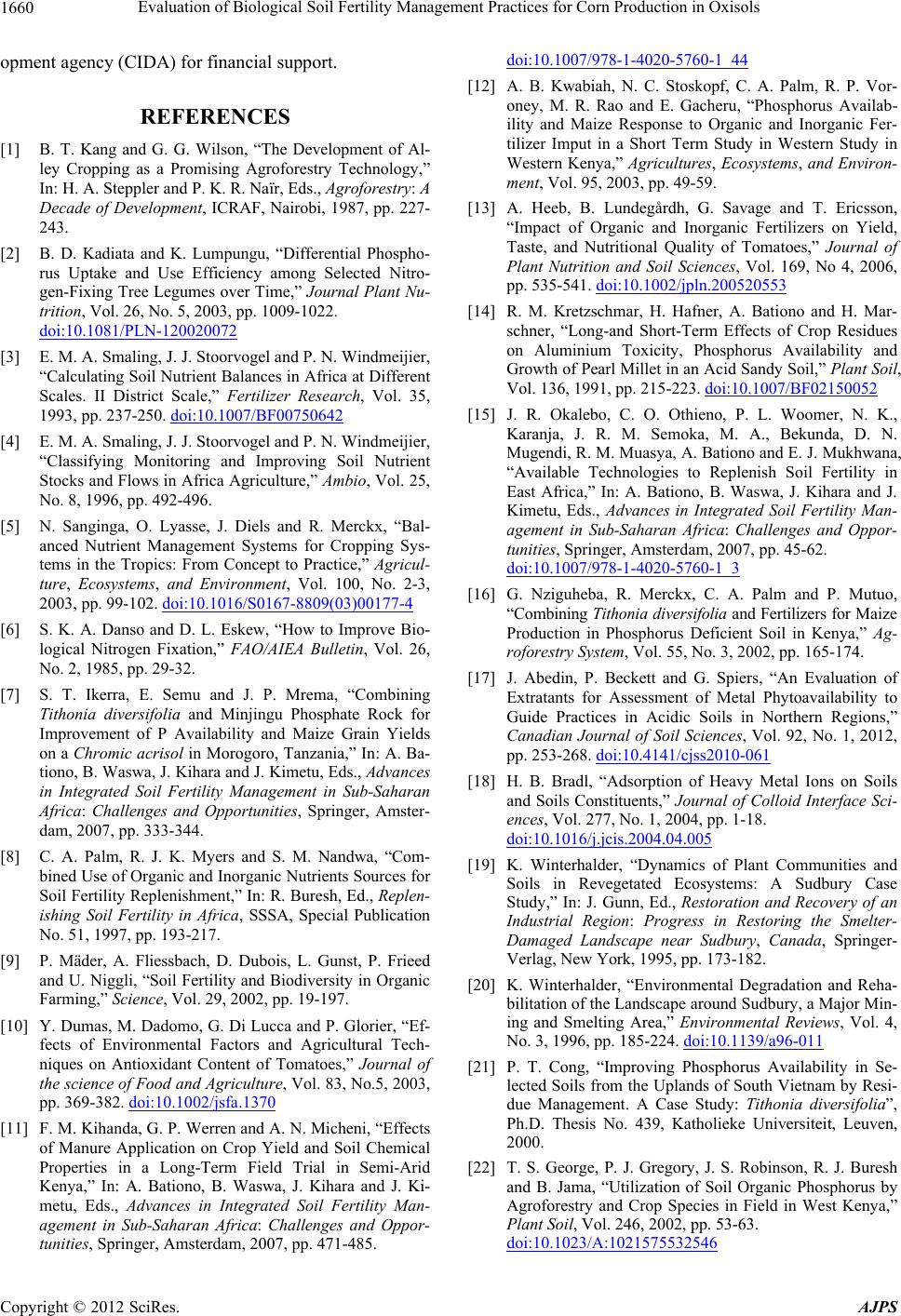
Evaluation of Biological Soil Fertility Management Practices for Corn Production in Oxisols
1660
opment agency (CIDA) for financial support.
REFERENCES
[1] B. T. Kang and G. G. Wilson, “The Development of Al-
ley Cropping as a Promising Agroforestry Technology,”
In: H. A. Steppler and P. K. R. Naïr, Eds., Agroforestry: A
Decade of Development, ICRAF, Nairobi, 1987, pp. 227-
243.
[2] B. D. Kadiata and K. Lumpungu, “Differential Phospho-
rus Uptake and Use Efficiency among Selected Nitro-
gen-Fixing Tree Legumes over Time,” Journal Plant Nu-
trition, Vol. 26, No. 5, 2003, pp. 1009-1022.
doi:10.1081/PLN-120020072
[3] E. M. A. Smaling, J. J. Stoorvogel and P. N. Windmeijier,
“Calculating Soil Nutrient Balances in Africa at Different
Scales. II District Scale,” Fertilizer Research, Vol. 35,
1993, pp. 237-250. doi:10.1007/BF00750642
[4] E. M. A. Smaling, J. J. Stoorvogel and P. N. Windmeijier,
“Classifying Monitoring and Improving Soil Nutrient
Stocks and Flows in Africa Agriculture,” Ambio, Vol. 25,
No. 8, 1996, pp. 492-496.
[5] N. Sanginga, O. Lyasse, J. Diels and R. Merckx, “Bal-
anced Nutrient Management Systems for Cropping Sys-
tems in the Tropics: From Concept to Practice,” Agricul-
ture, Ecosystems, and Environment, Vol. 100, No. 2-3,
2003, pp. 99-102. doi:10.1016/S0167-8809(03)00177-4
[6] S. K. A. Danso and D. L. Eskew, “How to Improve Bio-
logical Nitrogen Fixation,” FAO/AIEA Bulletin, Vol. 26,
No. 2, 1985, pp. 29-32.
[7] S. T. Ikerra, E. Semu and J. P. Mrema, “Combining
Tithonia diversifolia and Minjingu Phosphate Rock for
Improvement of P Availability and Maize Grain Yields
on a Chromic acrisol in Morogoro, Tanzania,” In: A. Ba-
tiono, B. Waswa, J. Kihara and J. Kimetu, Eds., Advances
in Integrated Soil Fertility Management in Sub-Saharan
Africa: Challenges and Opportunities, Springer, Amster-
dam, 2007, pp. 333-344.
[8] C. A. Palm, R. J. K. Myers and S. M. Nandwa, “Com-
bined Use of Organic and Inorganic Nutrients Sources for
Soil Fertility Replenishment,” In: R. Buresh, Ed., Replen-
ishing Soil Fertility in Africa, SSSA, Special Publication
No. 51, 1997, pp. 193-217.
[9] P. Mäder, A. Fliessbach, D. Dubois, L. Gunst, P. Frieed
and U. Niggli, “Soil Fertility and Biodiversity in Organic
Farming,” Science, Vol. 29, 2002, pp. 19-197.
[10] Y. Dumas, M. Dadomo, G. Di Lucca and P. Glorier, “Ef-
fects of Environmental Factors and Agricultural Tech-
niques on Antioxidant Content of Tomatoes,” Journal of
the science of Food and Agriculture, Vol. 83, No.5, 2003,
pp. 369-382. doi:10.1002/jsfa.1370
[11] F. M. Kihanda, G. P. Werren and A. N. Micheni, “Effects
of Manure Application on Crop Yield and Soil Chemical
Properties in a Long-Term Field Trial in Semi-Arid
Kenya,” In: A. Bationo, B. Waswa, J. Kihara and J. Ki-
metu, Eds., Advances in Integrated Soil Fertility Man-
agement in Sub-Saharan Africa: Challenges and Oppor-
tunities, Springer, Amsterdam, 2007, pp. 471-485.
doi:10.1007/978-1-4020-5760-1_44
[12] A. B. Kwabiah, N. C. Stoskopf, C. A. Palm, R. P. Vor-
oney, M. R. Rao and E. Gacheru, “Phosphorus Availab-
ility and Maize Response to Organic and Inorganic Fer-
tilizer Imput in a Short Term Study in Western Study in
Western Kenya,” Agricultures, Ecosystems, and Environ-
ment, Vol. 95, 2003, pp. 49-59.
[13] A. Heeb, B. Lundegårdh, G. Savage and T. Ericsson,
“Impact of Organic and Inorganic Fertilizers on Yield,
Taste, and Nutritional Quality of Tomatoes,” Journal of
Plant Nutrition and Soil Sciences, Vol. 169, No 4, 2006,
pp. 535-541. doi:10.1002/jpln.200520553
[14] R. M. Kretzschmar, H. Hafner, A. Bationo and H. Mar-
schner, “Long-and Short-Term Effects of Crop Residues
on Aluminium Toxicity, Phosphorus Availability and
Growth of Pearl Millet in an Acid Sandy Soil,” Plant Soil,
Vol. 136, 1991, pp. 215-223. doi:10.1007/BF02150052
[15] J. R. Okalebo, C. O. Othieno, P. L. Woomer, N. K.,
Karanja, J. R. M. Semoka, M. A., Bekunda, D. N.
Mugendi, R. M. Muasya, A. Bationo and E. J. Mukhwana,
“Available Technologies to Replenish Soil Fertility in
East Africa,” In: A. Bationo, B. Waswa, J. Kihara and J.
Kimetu, Eds., Advances in Integrated Soil Fertility Man-
agement in Sub-Saharan Africa: Challenges and Oppor-
tunities, Springer, Amsterdam, 2007, pp. 45-62.
doi:10.1007/978-1-4020-5760-1_3
[16] G. Nziguheba, R. Merckx, C. A. Palm and P. Mutuo,
“Combining Tithonia diversifolia and Fertilizers for Maize
Production in Phosphorus Deficient Soil in Kenya,” Ag-
roforestry System, Vol. 55, No. 3, 2002, pp. 165-174.
[17] J. Abedin, P. Beckett and G. Spiers, “An Evaluation of
Extratants for Assessment of Metal Phytoavailability to
Guide Practices in Acidic Soils in Northern Regions,”
Canadian Journal of Soil Sciences, Vol. 92, No. 1, 2012,
pp. 253-268. doi:10.4141/cjss2010-061
[18] H. B. Bradl, “Adsorption of Heavy Metal Ions on Soils
and Soils Constituents,” Journal of Colloid Interface Sci-
ences, Vol. 277, No. 1, 2004, pp. 1-18.
doi:10.1016/j.jcis.2004.04.005
[19] K. Winterhalder, “Dynamics of Plant Communities and
Soils in Revegetated Ecosystems: A Sudbury Case
Study,” In: J. Gunn, Ed., Restoration and Recovery of an
Industrial Region: Progress in Restoring the Smelter-
Damaged Landscape near Sudbury, Canada, Springer-
Verlag, New York, 1995, pp. 173-182.
[20] K. Winterhalder, “Environmental Degradation and Reha-
bilitation of the Landscape around Sudbury, a Major Min-
ing and Smelting Area,” Environmental Reviews, Vol. 4,
No. 3, 1996, pp. 185-224. doi:10.1139/a96-011
[21] P. T. Cong, “Improving Phosphorus Availability in Se-
lected Soils from the Uplands of South Vietnam by Resi-
due Management. A Case Study: Tithonia diversifolia”,
Ph.D. Thesis No. 439, Katholieke Universiteit, Leuven,
2000.
[22] T. S. George, P. J. Gregory, J. S. Robinson, R. J. Buresh
and B. Jama, “Utilization of Soil Organic Phosphorus by
Agroforestry and Crop Species in Field in West Kenya,”
Plant Soil, Vol. 246, 2002, pp. 53-63.
doi:10.1023/A:1021575532546
Copyright © 2012 SciRes. AJPS